If we are going to use livestock to produce food, we need to work out how to do so sustainably. It has always been a source of frustration to me that so much food is wasted, yet we cannot legally use it to feed our livestock, leaving them munching away on food which could have been used to feed people. It is never an issue which I have taken the time to look into, however, and I was fascinated to be able to talk to Karen Luyckx who campaigns for changes to the legislation banning the feeding of kitchen scraps to omnivores such as pigs and chickens.
Karen is a project manager at Feedback, a campaign group that works to regenerate nature by reducing the demands placed on it by the food system. Karen herself has witnessed the destruction caused by soya production while living in Bolivia: soya which is produced to supply the global meat industry. Feedback believes we can build a better food system: a low input, low impact system, where waste is vastly reduced, and unavoidable waste is repurposed and reused. This ‘waste’ would become a resource, reducing inputs and reducing pollution.
Karen agrees that wherever possible food waste should be avoided, and surplus food should be used to feed people who need it. Some level of waste is unavoidable, however, and Feedback believe feeding surplus food to pigs and chickens is an important part of the solution. Composting and anaerobic digestion have a part to play, too, but these processes don’t provide the carbon savings of using surplus food as livestock feed. ‘The pig Idea’ is a Feedback campaign encouraging the feeding of surplus food that is no longer fit for human consumption to pigs.

The food use hierarchy (WRAP)
What are the benefits?
Feeding food surplus to livestock would reduce the reliance on unsustainable crops such as soya, and crops which could otherwise be used to feed humans. This benefits farmers as well as the environment: feed can be over 60% of the total costs of production for pig farmers. Karen observes that, with Brexit looming, British farmers may need all the help they can get.
There could also be benefits to animal welfare: the easing of pressure on margins may enable farmers to invest more in their animals’ welfare and experiment with less intensive systems; it could also mean these animals would receive a more natural diet, because in many cases we are feeding naturally omnivorous animals (such as pigs and chickens) a vegetarian diet. Karen tells me this may be a contributing factor in issues such as tail biting.
There seems to be considerable support within the industry for the proposal; indeed, a recent survey by Cambridge university found that 75% of UK pig farmers and agricultural professionals support using surplus food to feed pigs provided there are sufficient safeguards in place.

A wild boar eating meat (pic: Thimindu, creative commons).
What are the current regulations?
The current regulations came in after the 2001outbreak of foot-and-mouth disease. It is essentially illegal to feed any foodstuff which has been through a kitchen, or contains animal protein, to livestock. These rules apply to all livestock: non-ruminant omnivores as well as herbivores.
Karen claims the current legislation is complicated and confusing, and that, in many cases, surplus food is not used to feed animals because people do not understand the rules, or are afraid of getting things wrong. One of Feedback’s objectives is to increase the use of legally permissible food waste – such as bakery products, and fruit and vegetables – as feed, by improving understanding of the current rules. They have developed an animal feed tool to help food businesses and farmers clarify what surplus food it is permissible to use. Give it a try!
Feedback’s objective, in terms of legislation, is to “Change European law to allow food waste including catering waste to be diverted for use as pig and chicken feed; and to introduce a robust legal framework for its safe processing and use to prevent the outbreak of animal diseases”. This proposal differs from the legislation pre-2001 in that surplus food would only be fed having been processed in a specialist off-farm treatment plant with strict bio-security measures. The ‘treatment’ involves heating the food to destroy pathogens such as foot-and-mouth and swine fever.

Pigs eating pumpkins (Cedar summit farm, creative commons)
Would it be safe?
Karen points out that other countries – The US and Japan for example – do have a regulated, and apparently safe, system for feeding surpluss food to pigs. Earlier this year REFRESH (a European project taking action on food waste) published a report from a panel of experts including epidemiologists and micro biologists. The experts reviewed the evidence, including the Japanese model, and concluded that it is possible to safely feed food waste treated through heat and acidification. Feedback accepts that a robust design of a system to prevent cross contamination would be needed, and, through the REFRESH partnership, is working with microbiologists to develop risk management strategies.
A concern that is sometimes raised around feeding surplus food to livestock is the possibility of the transfer of prion disease (such as BSE). As previously mentioned, the legislation does not distinguish between ruminants and non-ruminant omnivores. Chickens and pigs have never naturally had prion diseases, and Karen tells me the only way researchers have managed to make it happen is by direct injection into the brain, which is biologically impossible under natural circumstances!

Feeding a pig salad leaves (pic: Becker1999, creative commons).
What about smallholders?
Even under Feedback’s main proposal, feeding food surplus to pigs could remain impractical for the smallholder given the small volume of food waste they would require, and the need for scraps to be processed in large treatment plants. Karen feels that smallholders require a different approach.
In the US, householder’s scraps can be fed to their own pigs on the premises without treatment, and in some EU countries the ban is not enforced with smallholders. Karen does not endorse a complete exemption for smallholders but points out that the risks of infection and disease emergence are associated with large-scale intensive systems, with high stocking density and low genetic diversity. Further, it is well known that in the UK a significant proportion of smallholders do feed kitchen scraps to their animals, despite the regulations: allowing this to happen in a regulated way could actually reduce the risk of contamination.
Karen is developing a proposal whereby very small-scale producers, with limited movement of animals, and a minimum distance from larger establishments, would be able to feed scraps from strictly vegetarian kitchens directly. She would love to speak to smallholders about their experiences and the practicalities of the proposal so please do comment below if you would like to get in touch.

A poster from world war II
Next steps
Next, Feedback want to further explore the business case for building waste food treatment plants. The model is well established and works well in Japan, where feed from heat-treated surplus food is sold at half the cost of conventional feed, but we need to establish whether it would provide the same economic benefits in Europe.
After strengthening the business case Karen feels they need to return to the public campaign – rebuilding public confidence in feeding surplus food to pigs, while continuing the dialogue with policy makers. The impact of the foot-and-mouth outbreak was devastating: huge damage was done to the farming community and huge economic and reputational damage occurred more widely. This resulting, highly risk-averse, climate has been compounded by more food scandals in recent years and Karen thinks this is what makes policy makers so reluctant to revisit the restrictions.

North Yorkshire moors during the foot mouth outbreak (pic: Ben Gamble, creative commons).
Let us know what you think
I have been very impressed with Feedback’s work. I find their proposal convincing, and it seems to be backed up by sound science. While we must consider the risks of feeding surplus food we also need to consider the risks of not doing so: of deforestation, pollution and food shortages. I hope to explore the opposing argument as well and may post a blog in the next month or two putting the case against feeding surplus food to pigs.
Do leave your thoughts, experiences and questions below and Karen will be happy to respond. For more information and links to further reading and research visit The Pig Idea

Image from Feedback

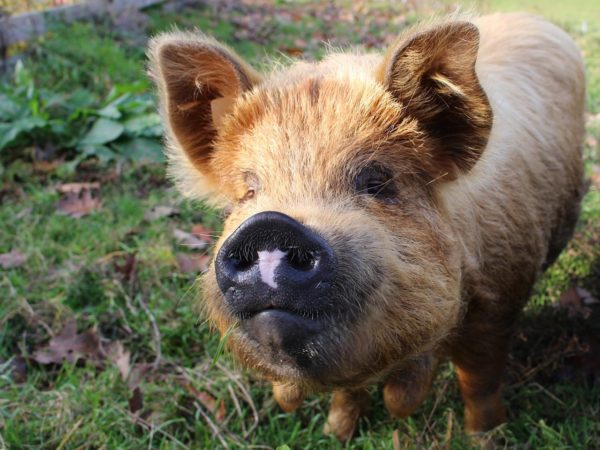
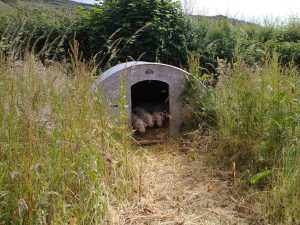
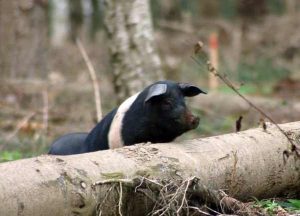
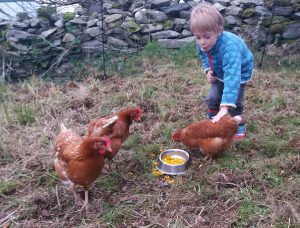

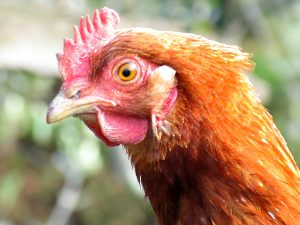
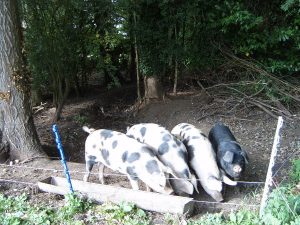
6 Comments
Possibly I’m seeing conspiracy where none exists but it strikes me that the current regulations benefit large multi-national agri-business. Plus most of the domestic poultry keepers are not aware the law applies to them and so ignore it.
John, surely you’re not saying that multinational corporations are so powerful that they can influence our political processes, and so corrupt that they would do it? [Just to be crystal clear, I’m being sarcastic – I’ve been stung by this approach in the past]. It seems fair that regulations should be imposed and costs borne by the industrial agriculture sector that keeps and feeds animals unnaturally, then transports them large distances, rather than by smallholders who have been successfully giving waste food to animals for millennia.
Yes Dave, I’m completely paranoid! 🙂 I believe we’re going to see a biblical scale disaster due to corporate farming that treats the land as an endless resource and measures everything by short-term financial metrics. As I said in my article on feeding waste, the basis of banning it was based on a false premise. Waste food didn’t cause foot and mouth, poor treatment of the waste and the illegal importation of meat did. The corporates would like nothing more than driving small scale producers out of the market – and waste feeding is something that doesn’t make sense for the large producers.
Absolutely
I don’t see why, as long as the pig farmer complies with the animal by-products regulations, they should not be encouraged to feed waste-food to their pigs.